![]()
Bukit Tunggal School Revisited 2001
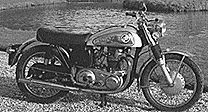 The year 1961. I was in Std Four, a new level equivalent nowadays to Primary Level Two, in the morning session. English was introduced and CheGu Mohamad was the English teacher, a big dark-skin teacher, always dressed in all-white, as it was a uniform for the teachers those days. The lady teachers were allowed to wear pink garment, but still white baju kurung, plus a matching scarf if she preferred. CheGu Mohamad came to school on a big Norton, matching his body. One day when he was finishing his lesson he said that his next lesson, which would be the next day, would be how to say our names in English. So, until the next day I kept thinking to myself impatiently what would my name be in English. And the next day CheGu Mohamad came to the class, began his lessons, kept his promise, but what a frustration when I found out that my name in English was the same as what I was called, contrasting my impression that it would be otherwise.
The year 1961. I was in Std Four, a new level equivalent nowadays to Primary Level Two, in the morning session. English was introduced and CheGu Mohamad was the English teacher, a big dark-skin teacher, always dressed in all-white, as it was a uniform for the teachers those days. The lady teachers were allowed to wear pink garment, but still white baju kurung, plus a matching scarf if she preferred. CheGu Mohamad came to school on a big Norton, matching his body. One day when he was finishing his lesson he said that his next lesson, which would be the next day, would be how to say our names in English. So, until the next day I kept thinking to myself impatiently what would my name be in English. And the next day CheGu Mohamad came to the class, began his lessons, kept his promise, but what a frustration when I found out that my name in English was the same as what I was called, contrasting my impression that it would be otherwise.
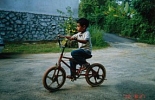 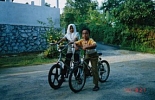
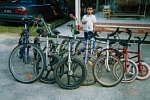
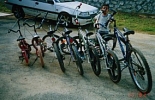 Small bicycles like these, noncolourful though, mostly all-black, appeared in my kampung when I was about ten. It was ridden by kids of a rich family. Being a child, my heart instantly attracted to it, and dreamed to have one. During one of the Eid, my brother rented for one hour, 20 cents (from his Raya money), at Cina Panjang bicycle shop in Batu Enam. We shared riding it to go to Mak Teh's place. I never told my mother of this dream, but I kept on dreaming and imagining of owning one, throughout my childhood life. And the dream never come through, until in my adult life, I bought many of them; all and one each, to every one of my children, boys and girls. It is not an act of vengeance; it is the fact that my children live in different time than I did, or perhaps they have a luckier father than I did. It was in this particular year Eid that my only Raya dress was not the usual new school uniform; it was a three-piece Baju Melayu, maroon in colour, the kind of fabric that discoloured every time it was washed; the only pair I ever had in my kiddy years. I could not afford one, not even during the four years tenure in SAS (1967-1970 - somehow I survived without it, whereas it was a must for every pupil) until 1974 when I was going to UK for my master degree. Most of the time our Raya dress would be ready a few days before; and after the Raya eve, we would be rehearsing the dress, many times; especially the shoes because by then we would have forgotten how to tie our shoes because we had only a pair a year. |
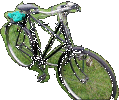 |
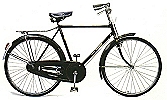 |
My father used to have a bicycle like this (left), but it was so rusty, the colour had changed from black to rusty-red. He went to work on bicycles and when we were going to visit my mother's relatives in Pantai, he rode his bicycle while we went by bus; he never went by bus because he never stayed longer than us. I remembered in one occasion, he sent by brother and me by bicycle to spend our times in Pantai; we returned home by following MakLong Su or MakNgah Mandak to Tepoh Market (on predetermined day) where my father would pick us up. He baught for us (used) one of a more sporty (right) when I was about seven or eight; most of the time my brother used it. When my brother left the school, he "owned" the bicycle for his works, to its life. Sometimes I braved myself riding my father's bicycle to school when he was not working, but it was so rusty, I was scared to take it right into the school compound in case my friends use it to embarass me; I usually parked the bicycle under Ismail's house which was a few hundreds meters away from the school. I learned to ride when I was about eight. One always needed the help of an adult or a big brother to learn riding bicycle because it was very much bigger; in case when it fall, it would fall like a tree. Firstly one learn to "pimpin" (to tag along) the bike, alone. Then with the adult holding, he began to ride from one side (impossible to stride because the bike was so high); this would take many weeks until he could balance it and ride alone. From this point he would keep on practising. He would then advance to the striding stage (on the bar, not the seat). When he 'passed' and skilful at this stage he practically would go anywhere, including to Batu Enam. When I borrowed my father's bicycle to go to school, I was in the striding stage. To ride on the seat, one has to wait probably till twelve or older. There were no 'affordable' bicycles for kids.
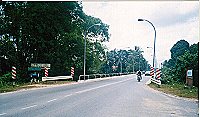 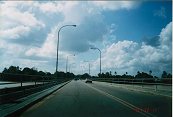 At about this time two important bridges: Buluh Gading Bridge (left), and its bigger sister, Manir Bridge (right) were built simultaneously. The connecting roads were yet to be built, although the cycle path were already there, to Batu Enam from Buluh Gading, and to Simpang Tok Ku from Manir; and through the padi fields from Buluh Gading to Manir; Losong Ferry was still operating to go to K Terengganu by road. I had no chance at all to see the latter being constructed, but the former, it was another fun to see it being built, piece by piece. Almost every day after school I went to see it being built; it was about one km from my house. I watched almost every column of the bridge being concreted and then pounded into the river bed; a very distinct pounding sound unheard of before, audible many kilometers away. Sometimes when I heard the pounding sound from my house while I was playing, I ran as quickly as I could at that very moment to the place to see the column being pounded, leaving everything behind. One day a lot of people were on both banks of the river and every one was enquiring what every one was seeing. It appeared that one of the Indian workers (all of them were Indian in the set) had drowned in the river and feared dead. It was a jovial day when finally a bridge was spanning across the river, not yet passable by even a motocycle, the builder had already let the pedestrian and cyclist used it (they had sure that the users would not fall into the river), instead of by rowing-boat to cross the river, zig-zagging and tip-toeing among the steel structure and the wooden mould. |
I wanted to do many extra-curriculum in the school, but as most of the activities were carried out in the evening, it inhibited a lot since coming back to the school in the evening was a privilege to those who stayed near the school. But most of all was that those activities required new overhead which overrode every intention. I wanted to be the school athlete, but since I never attended the practice I was not selected. I once took part in the Inter-School Sports, in thug of war event. The event was held in Sekolah Tok Jiring, on the other direction from my house. On that day we were transported in a car belonging to the area Nazir whose office was in my school. Twelve of us all together in the car, a Ford Prefect. We lost in the event.
I had many relatives, and thus friends, staying around Batu Enam and Tok Jiring. I was tempted many times to join their 'culture' which was more of land- and farm-based, compared to my 'culture' in Pengkalan Arang which was river-based. So, on many occasions I joined them, and some how I ended up becoming a pupil at the famous religious school in Tok Jiring, the Pondok Haji Abas (this school turned to become Sekolah Menengah Agama Tok Jiring when Federal Government took over in late 1970's, consented by the founder: Haji Abas), without even my mother or my father's insistence, the daily school, in the afternoon session. On the first day, I was put in Std 1C, the very beginner class. On the day the class read Verse 96:16, which was well in my head since many years ago, even before I went to Bukit Tunggal. I read it with my mother when she taught the kids around the kampung reading Quran. The class utz, Utz Awin noticed it, and every body noticed it, and they noticed it more than that since I had not only finished my Muqaddam at home, but already about half of the Quran, which I read every night with Pak Itam Ghani, near my house. It was immediately brought to the attention of the Mudir, Utz Abdullah and the next day I was promoted even by-passing the Utz Raja's Std 1B, intermediate class, to his class, Std 1A, the most senior class whose other pupils were not only much older than myself, some of them more than twice my age, and they were even closer to my father than myself, and included one blind man, Muhamad who would become a Hafiz in the school. Perhaps because I was just expanding my domain, the school was even further than to Bukit Tunggal, and on the other side of the direction. At one point it flashed into my thinking of the cheaper cost to go to this school, than the Primary School. There was no certain uniform. I normally wear any no-bad-smell shirt and a sarong (pelikat), the only sarong we had in the family, the same sarong my father would wear to go to Friday prayer (my mother would wash in the morning after my last use on Thursday evening); plenty of "natural" foods along the way to the school: the kemunting, the cashews, and the food brought by my older classmates (cassava, local fruits, etc); plenty of fresh well-water along the way to the school and around the school; I never felt hungry, unlike that of my early experience in Primary school many years ago; no text-books, very minimum exercise books. I enjoyed going the the religious school more than to the Primary school; I never felt I scared of anything in this school.
 A toy-pistol like this was the kid favourite toy during Eid in my time. It is an amazement that this made-in-China toy survived into the third millenium. (Well, this one belonged to my son #6 in 1999 - I borrowed it without him knowing why I photographed it). In my time it cost 15 to 60 cents depending on model and sophistication. I was rather fortunate that I could have one, out of the Raya money given by my relatives, the thing my mother could not afford to say it was a waste because every boy around had one. On non-raya days we would make our own gun (well as long as it gives a 'bang' sound; the louder the better). There were two types: One by using chinese bamboo; a 'ruas' (the longger the better) was cut to make the berrel; the piston was made by stripping to size and length with a sharp knife another bigger bamboo, with a short handle-end made from the similar chinese bamboo. The bullets were 'ara' fruits (which we collected in the 'forest', or in emergency the senduduk fruit. The fruits gave a 'bang' sound when jerk-forced out through the barrel by the piston. Another method of making the gun was by using old bicycle spoke. The spoke was bent to make a "L" shape; the head-screw was reverted, into which stripped match-head (sulphur) was stuffed in. A blunted nail of fit-size was inserted; on a blow onto a hardsurface such as a stone would give a satisfactory 'bang' sound. This gun cost money because matches had to be bought. The bamboo gun was extended to the bamboo cannon we made during raya times. To make this cannon 'buluh duri' or 'buluh betong' (a kind of big and thick-walled bamboo) were used. Several 'ruas' were cut, the 'buku' were removed by chipping using an iron bar, leaving the last one, closest to the base, to make it essentially a vessel structure. It was firmly laid on the ground just like a cannon. To fire, some water was poured into it from the font-end and a piece of carbide (easily available in the sundry shops) was thrown in; a fire is applied at the hole made near the base; and a very loud explosion sound would result. This was very dangerous, but throughout my childhood I never heard my friend got any accidental hurts. When the adults, or bigger youngsters joined, they even extended to make the cannon using a coconut tree trunk as the barrel (about ten feet long - the inside was chipped away using a long iron-chistle) and it was buried in the ground for stability. The sound from this cannon was so loud that it could be heard outside of neighbourhood. A toy-pistol like this was the kid favourite toy during Eid in my time. It is an amazement that this made-in-China toy survived into the third millenium. (Well, this one belonged to my son #6 in 1999 - I borrowed it without him knowing why I photographed it). In my time it cost 15 to 60 cents depending on model and sophistication. I was rather fortunate that I could have one, out of the Raya money given by my relatives, the thing my mother could not afford to say it was a waste because every boy around had one. On non-raya days we would make our own gun (well as long as it gives a 'bang' sound; the louder the better). There were two types: One by using chinese bamboo; a 'ruas' (the longger the better) was cut to make the berrel; the piston was made by stripping to size and length with a sharp knife another bigger bamboo, with a short handle-end made from the similar chinese bamboo. The bullets were 'ara' fruits (which we collected in the 'forest', or in emergency the senduduk fruit. The fruits gave a 'bang' sound when jerk-forced out through the barrel by the piston. Another method of making the gun was by using old bicycle spoke. The spoke was bent to make a "L" shape; the head-screw was reverted, into which stripped match-head (sulphur) was stuffed in. A blunted nail of fit-size was inserted; on a blow onto a hardsurface such as a stone would give a satisfactory 'bang' sound. This gun cost money because matches had to be bought. The bamboo gun was extended to the bamboo cannon we made during raya times. To make this cannon 'buluh duri' or 'buluh betong' (a kind of big and thick-walled bamboo) were used. Several 'ruas' were cut, the 'buku' were removed by chipping using an iron bar, leaving the last one, closest to the base, to make it essentially a vessel structure. It was firmly laid on the ground just like a cannon. To fire, some water was poured into it from the font-end and a piece of carbide (easily available in the sundry shops) was thrown in; a fire is applied at the hole made near the base; and a very loud explosion sound would result. This was very dangerous, but throughout my childhood I never heard my friend got any accidental hurts. When the adults, or bigger youngsters joined, they even extended to make the cannon using a coconut tree trunk as the barrel (about ten feet long - the inside was chipped away using a long iron-chistle) and it was buried in the ground for stability. The sound from this cannon was so loud that it could be heard outside of neighbourhood. |
The experiences in the religious school taught me many expensive lessons, perfected by the friendship with the class-mates very much older than myself. These lessons apparently were prepared for me to face the coming years, when I was needed to be more mature than I was. It was unfortunately thus a short duration, less than a year, I quitted the school. I did not remember what actually triggered my decision to quit, but I remembered after about a month I was absent, Utz Abdullah came to my house, met my father and tried unsuccessfully to persuade me to go back to his class.
At the end of Std 4, there was an examination called Special Malay Examination. Every one in Std 4 sat for the exam. Only two subjects were tested: math which was taught in the class and "Ujian Taakul" (something like intelligent test) which was not taught in the class. If one scored (or "pass") in the exam, he would be offered to go to English School in Kuala Terengganu, those days it was Sultan Sulaiman Primary School, Jalan Batas Baru. I did not make it. My classmate Ismail Embong made it. He went to SS Primary School, following the foot steps of his elder brothers who all went to english school. But he could not catch up with the 'metropolitan' needs of the english school. He did not proceed quite far; tens of years later I learned that his schooling path ceased at LCE only. It was a blessing that I did not make it, because my difficulties would be many hundred times more than Ismail.
I remembered a couple of Exhibition Days in which pupil showed their handicraft products, but I did not remembered any award presentation perhaps because I never won any award. In one exhibition day, I made for show a wooden parang from excess wood of my father, and then painted it red at AyahLi's metal workshop. My brother's was picked up for some kind of "excellent" for his relief-map of Borneo Island (which looked like a rotting dead goat) made from crushed starch-soaked old papers and water-colour. A few years after that I tried my luck, following my brother by making the 'north america' which was not very different from 'the borneo'. It was good and beautiful, but others were better and more beutiful; or perhaps relief map was then not the article of the time any more.
 Alas, I was just a boy, my mother knew that, and she knew that a boy is a boy. Rubber bands like this, always in four colour: green, blue, red, and yellow, was a precious toys when I was a boy. One could afford only ten to twenty at one time. We used to wear it around our wrist. We played with it in stake-games; winning and loosing. Sometimes when we had plenty of it, we weaved it to make catapult, with peripheral funs to search for the strongest Y-shape bush-branch or root for the holder, and discarded leather shoes for the 'bullet' holder, and of course the bullet-gathering trips, either pebble-size stone from tarmac road pavement, especially the one being constructed, or thumb-size fruits like bertam, kept in the pocket or wrapped in the sarung we were wearing, followed by the 'hunting' trip which normally ended with an empty-handed return. What made rubber bands precious was that they were also used by seamstress to make waist-tight in pants. When my mother bought some for her use, I normally asked for one or two 'samples' as a starter; I normally won in games. Many kinds of stake-games could be played using rubber bands; the size of the stake depends on the size of the boy. Small boy played one-to-one stake, bigger boys played as many as fifty in one stake; but all of them involved hitting from a distance. Rubber seeds were another objects we were playing with. There were plenty of them around our place; but the game was to get the freshest, the lots that just fall from the tree, with the skin still shining, not muddy dull. We would know the rubber seed were falling from the sound of the bursting pods. In the stake-game, the seeds were lined straight; one seed, the most oval one was in the middle (Tokong); we rolled another seed from a distance. If the tokong was hit, he won all of the seeds in the line, any other seed hit, he won from that point outward. The roller seed was obviously the most round one and the heaviest. Sometimes we went further modifying the roller seed to make it heavy. First the biggest and the most round was picked, then it was fed inside a fire ant mound. The ants would eat the content of the seed, via a small natural hole in the seed, normally in one week in a big nest. The empty seed was then stuffed, through the same small hole, with clay mud as compact as possible and let to dry. The result was a big round and heavy rubber seed which would roll in a straight line, straight to hit the Tokong. We would keep the seeds we won under the house, so many of them that after sometimes they germinated. Another seasonal 'toy' that we played were the cigarette box, not the current flip-top type, but the old match-box-type which could be flattened for compact keeping. Each brand, by consensus had an attribute of value, obviously, the rarest had the highest value, usually a multiple of five. The "spade" brand was cheapest, only 5, because it was so common (inherently most adult smoked this brand because it was cheapest - 30 sen for a pack of ten), it could easily be found on many road sides, especially in the market place. Other brands were "the signal", "the gold leaf", "virginia gold", "555", and the highest was the "capstain". Again the stake-games all involved hitting from a distance with something, including discared battery. Alas, I was just a boy, my mother knew that, and she knew that a boy is a boy. Rubber bands like this, always in four colour: green, blue, red, and yellow, was a precious toys when I was a boy. One could afford only ten to twenty at one time. We used to wear it around our wrist. We played with it in stake-games; winning and loosing. Sometimes when we had plenty of it, we weaved it to make catapult, with peripheral funs to search for the strongest Y-shape bush-branch or root for the holder, and discarded leather shoes for the 'bullet' holder, and of course the bullet-gathering trips, either pebble-size stone from tarmac road pavement, especially the one being constructed, or thumb-size fruits like bertam, kept in the pocket or wrapped in the sarung we were wearing, followed by the 'hunting' trip which normally ended with an empty-handed return. What made rubber bands precious was that they were also used by seamstress to make waist-tight in pants. When my mother bought some for her use, I normally asked for one or two 'samples' as a starter; I normally won in games. Many kinds of stake-games could be played using rubber bands; the size of the stake depends on the size of the boy. Small boy played one-to-one stake, bigger boys played as many as fifty in one stake; but all of them involved hitting from a distance. Rubber seeds were another objects we were playing with. There were plenty of them around our place; but the game was to get the freshest, the lots that just fall from the tree, with the skin still shining, not muddy dull. We would know the rubber seed were falling from the sound of the bursting pods. In the stake-game, the seeds were lined straight; one seed, the most oval one was in the middle (Tokong); we rolled another seed from a distance. If the tokong was hit, he won all of the seeds in the line, any other seed hit, he won from that point outward. The roller seed was obviously the most round one and the heaviest. Sometimes we went further modifying the roller seed to make it heavy. First the biggest and the most round was picked, then it was fed inside a fire ant mound. The ants would eat the content of the seed, via a small natural hole in the seed, normally in one week in a big nest. The empty seed was then stuffed, through the same small hole, with clay mud as compact as possible and let to dry. The result was a big round and heavy rubber seed which would roll in a straight line, straight to hit the Tokong. We would keep the seeds we won under the house, so many of them that after sometimes they germinated. Another seasonal 'toy' that we played were the cigarette box, not the current flip-top type, but the old match-box-type which could be flattened for compact keeping. Each brand, by consensus had an attribute of value, obviously, the rarest had the highest value, usually a multiple of five. The "spade" brand was cheapest, only 5, because it was so common (inherently most adult smoked this brand because it was cheapest - 30 sen for a pack of ten), it could easily be found on many road sides, especially in the market place. Other brands were "the signal", "the gold leaf", "virginia gold", "555", and the highest was the "capstain". Again the stake-games all involved hitting from a distance with something, including discared battery. We enjoyed playing this game when we were small. When the adult congregated, they had fun playing the games the kiddies could not. These adult enjoyed the games the kiddies enjoyed. The games they enjoyed that the kiddies could not are not full of fun, costly and needed deliberation. They thus do not quite grow up. We enjoyed playing this game when we were small. When the adult congregated, they had fun playing the games the kiddies could not. These adult enjoyed the games the kiddies enjoyed. The games they enjoyed that the kiddies could not are not full of fun, costly and needed deliberation. They thus do not quite grow up. |
At home actually, this period of time was the beginning of my conscience, the feeling that I was needed to share the hard life with my mother and my father. I could see that my father was not as strong as I remembered he was, and my mother had to work hard in which ever way she could to feed us: sewing with the very old singer from whatever left funtioning, day work in somebody else padi planting and raising domestic stocks which did not need a cost. My elder brother began to step into the world of breadwinner even though he had not finished his Std 6 yet. Many times of the day, I was asked to help my mother in the kitchen, or at least there were some routine jobs that I was assigned to by my mother; some times I was not very careful, my mother raised her voice, or she got very angry when I returned home late in the evening from playing. Filling the water churn (tempayan) was my job, gathering firewoods was also my job. Bringing the goat home in the evening was also my job and gathering the leave-food for it (from bushes such as mengkudu) was shared with my brother. My father was not quite keen in the livestock, not even chicken because of his carpentering nature. Some times, cooking the rice; sometimes I felt embarassed when others knew that I helped in the kitchen when in other homes, only daughters helped in the kitchen; even I myself wished to have a big sister so that I could be freed from helping in the kitchen. My younger sister Mek Maziah was still very small to help, the best it could be hoped from her was playing with her little sister. My mother used to murmur that she wished to have a big daughter like other mothers so that she could leave the kitchen to her. Baby sitting my little sister was also my part time job; but advantageous that when I take my sister along, I could go 'anywhere' I like because my mother was free to do all the chorus at home. A few times I felt I sensed my mother was very stressful; and my elder brother who obviously understood it better than me, took the little sister away from home for a while, sometimes as far as Banggol Donas, MakNgah's place, so that my mother could be alone to unstress herself. At least on one occasion I remembered my brother took the sister on a bus (at Surau PakTeh) to visit TokChik in Hiliran. I wanted to go too, but my mother would not let because it would be too burdensome to my brother. I wept and kept tagging behind my brother along the way to the bus route. When the bus came, I finally conceded and returned home with my mother; after all my brother wanted to go for a day-trip. Many times my mother asked me to go to Batu Enam market to buy fish and other sundries in the evening. On this job, normally she instructed to which retailer (peraih) I should go to and exactly what fish to buy. Those days, fish were priced per 10 sen; such as 20 fish per ten sen (sardine, kembung, or selar) or five fish per ten sen (kerisi or big selar). When there were plenty of fish, they were priced per 100 fish, like 20 sen per 100 fish. For very small fish like bilis it was measured by volume, such as per pot. My mother rarely bought big fish like tenggiri or aya (tuna), because we feasted on even better fish and other exotic sea-foods when we visited my mother's relatives in Mengabang Telung. We also rarely bought local fruits, like rambutan and mangosteen, even durian; a matter of fact, villagers do not buy local fruits. Many owners were more than happy to share some of their harvest to neighbours, even with neighbours who also owned some trees. Every one most likely had a relative who owned fruit trees, or fruit orchard. Buying fruits were exclusively for towners in the markets. I washed myself the only school dress I had and the shoes, some times every afternoon after school, to keep them as "new" as possible. At one time I was so frustrated to see that my white shirt was full of black dots (jeragat). I almost weep, my mother shared the same sadness for me that he gave me ten sen to buy "chlorox" at Syed Ali's shop in Batu Enam; the dots did not disappear even after all the bleach was used; only that when the shirt dried the dots were not so visible.
In about this period also, an outbreak of cholera occurred in our locality. It was not very serious. At one moment I was very scared because I thought that the outbreak was an annual event. I was jabbed in the school, as were every school children. The villagers got them from mobile clinic who came normally at the mosque. I remembered AbgNgah, who then had built his home on his father's former site, near my home, had it; and he survived. Fortunately around my home I had not heard any body else got it.
 The Nerus river, a few hundreds meters from my home. The spot where the boats are at berth is the Pengkalan Arang, my river-based base spot when I was a boy in the 60's. Two different type of flora on the opposite banks: woody big trees on the east bank (Pengkalan Arang), and fibrous nipah on the west bank (Buluh Gading), thus harbouring two different fauna worlds. The water was clear, we drew our drinking water from this river, and we washed in this river. I learned to swim in this river on the very first time my mother dipped me in it. By ten I was a 'professional' swimmer. The river bank and the water-margin was my play ground. On reaching twelve, I swam across this river, first time with the help of a floater (nipah leaf bunch stalk) and later in free style. There were lives in the river: the fish and the prawns, and there were phenomena. This river was a transport vein to K Terengganu peripherals by motorised boats and row boats. There were jetties along the river for the boat to load and unload. In the morning we could hear the tooting sound of the boat engine en route to the town and the same sound in the late afternoon in reverse direction. In one year there was a grand festival at Padang Maziah, KT, perhaps accompanying the installation of the Sultan. I remembered following the adults going to see it, at night. In previous years, I remembered my mother took us to put up in TokChik's place in Hiliran (in the 'hut' before my father built a 'modern' one), and from there we went to see the festival. It was a very hard night for me because I was suffering from a night blindness and it was a dark-moon night.  During several Eids when I was a boy, there were organised water festivals, boat racing was one of the agenda. Buluh Gading was the site; that was before the bridge was made. In late second millenium, local politicians tried to revived this covalent fun, but not quite successful because they had mixed up the reasons. Occasionally, in this river there were convoys of festival boats carrying chinese upstream to Jeram where there was their Tokong. During several Eids when I was a boy, there were organised water festivals, boat racing was one of the agenda. Buluh Gading was the site; that was before the bridge was made. In late second millenium, local politicians tried to revived this covalent fun, but not quite successful because they had mixed up the reasons. Occasionally, in this river there were convoys of festival boats carrying chinese upstream to Jeram where there was their Tokong. |
By the end of this period of time two new roads were about ready to be used. One was from Batu Enam inwards through the Buluh Gading Bridge to Manir and the bridge and then straight to Simpang Tok Ku joining K Terengganu K Brang road. This one was not my locus, not yet before 1965. The other one was from Batu Enam through the 'forest' to Kubang Badak joining the existing beach road from Batu Rakit to Seberang Takir. I watched this one evolving from a foot-path to a cycle track to a four-wheelers track and eventually to a JKR-tarmac road. My father passed through this route from time to time to his work, or on occasions, carrying us on bicycle to visit my mother's relatives in the beach land. I remembered a spot in Pak Tuyu near Kubang Badak, along the road where there was a dark clear water stream, under the shade of adult gelam trees, my father always stopped, either to rest or for prayer (the place nowadays had become a part of the site of Kolej Universiti Sains dan Teknologi Malaysia (KUSTEM)). As I grew up I continued to pass through this route, alone, with mates, or with family. Beginning from this period of time my loci were more polarised towards this area than towards anywhere else, mingling with the activities of the road building and other peripheral development. One would not miss to notice during this period of time the speeding shuttling of many lorries, known to the locals as "stripe lorry" (from the paint of the body) which transported earth from Bukit Jong area to the road building sites. They ran very fast because the drivers were paid by trip (by the contractors), and thus they were very dangerous to the local road users. Many of the drivers were locals, who previously were timber lorry drivers. The interesting part of this phenomenon was that the drivers took their lorry to park at their homes. One of the lorry parked at night at home next to my home. The driver, AyahChik Mat (a distant relative of my father) was the son-in-law of MakNgah Long whose wedding I witnessed when I was a timid boy. So very soon, a lorry was no longer a strange moving thing that the kids around my home would chase. But more, the best part of it was during the "Beach Festival" (Main Pantai) after harvesting, something like in the middle of the year, in Pengkalan Maras and Tanjung Gelam, AyahChik Mat would load as many of us as the lorry could carry: kids, youngsters, and some adults, drove us to the beach, after Isyak, and enjoy the festival and returned home at about mid-night - a very convenient night trip. My brother and I never miss the trips; when the beach festival season arrived, we kept our ears open for news when AyahChik Mat would take us to the beach. My mother let us go with only one reminder: don't miss the trip home. There were also similar festival in Batu Buruk beach, but I never go there because we had more than enough of the beach festival in Pengkalan Maras and Tanjung Gelam.
Edition dated: April 2003